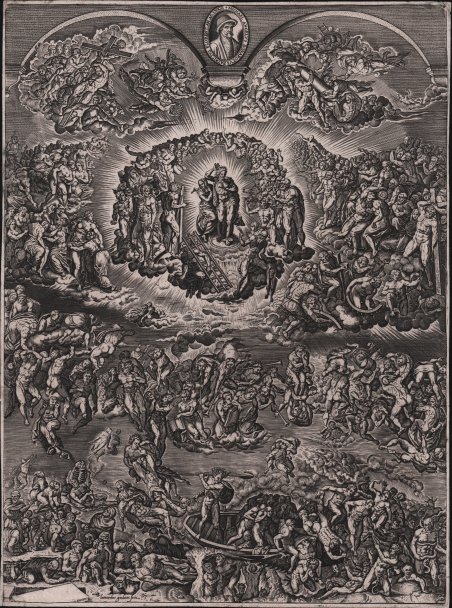Bulino, circa 1600; nell’ovale intorno al ritratto «MICHAEL ANGELVS BONAROTVS PATRICIVS FLORENT. AN. AG. LXXIII», in basso verso sinistra «leonardus gaultierfecit». Traduzione a stampa del celebre affresco di Michelangelo nella Cappella Sistina. Esemplare del primo stato di tre, prima dell'indirizzo di Pierre Mariette. Come sottolinea Alessia Alberti, tra le incisioni che riportano in alto il ritratto di Michelangelo all’età di 73 anni, questa potrebbe essere l’ultima a livello cronologico. Probabilmente l’opera afferisce alla produzione di Gaultier già primo secentesca. Questo gruppo di opere è accomunato da altri particolari iconografici come la presenza, nella zona inferiore sinistra e in primo piano, di una lastra tombale, il fondo completamente tratteggiato e l’ampia nube che si diffonde dietro le figure in primo piano a destra. Ne deriva che potrebbero essere tutte ricondotte a un unico prototipo, o la stampa del Monogrammista CBS oppure una comune fonte a disegno. Restano in ogni caso impressionanti le somiglianze, come già rilevato da Giovanni Agosti, con la miniatura con questo soggetto prodotta nell’ambito di Giulio Clovio e oggi conservata a Casa Buonarroti. Léonard Gaultier, nato nel 1561 a Magonza e morto poco dopo il 1635 a Parigi, è stato un disegnatore, incisore e illustratore francese. Insieme a Thomas de Leu, fu uno dei grandi stampatori del suo tempo. Léonard era figlio di Pierre Gaultier, un mercante orafo di Parigi. Fu allievo di Étienne Delaune a Strasburgo e in seguito lavorò principalmente per gli editori di Lione e Parigi. Precoce, le sue prime incisioni risalgono al 1576. Per alcune delle sue incisioni di grandi dimensioni si ispirò ad Antoine Caron, di cui sembra fosse il genero. Soprattutto, sviluppò l'arte del ritratto calcografico. Si stabilì a Parigi nel 1585 con l'insegna Arche de Noé, in rue du Monceau-Saint-Gervais, poi, nel 1599, come molti commercianti di stampe, in rue Saint-Jacques, con l'insegna Fleur du Lys d'or. Magnifica prova, ricca di toni, impressa su carta vergata coeva, rifilata al rame, in ottimo stato di conservazione. Firma di collezione al verso di Naudet, con la data 1792 (Lugt no. 1937). Bibliografia IFF / Inventaire du Fonds Français: Bibliothèque Nationale, Département des Estampes (17); Alessia Alberti, d’Après Michelangelo, n. 192, I/III. Engraving, circa 1600; in the oval around the portrait "MICHAEL ANGELVS BONAROTVS PATRICIVS FLORENT. AN. AG. LXXIII" lower left verso "leonardus gaultierfecit." Printed translation of Michelangelo's famous fresco in the Sistine Chapel. Example from the first state of three, before Pierre Mariette's address. As Alessia Alberti points out, among the engravings that show Michelangelo's portrait at age 73 above, this may be the last one chronologically. The work probably pertains to Gaultier's already early seventeenth-century production. This group of works is united by other iconographic details such as the presence, in the lower left and foreground, of a tombstone slab, the fully hatched background, and the large cloud spread behind the figures in the right foreground. It follows that they could all be traced to a single prototype, either the Monogrammist CBS print or a common drawing source. In any case, the similarities remain striking, as already noted by Giovanni Agosti, with the miniature with this subject produced in the circle of Julius Clovius and now preserved in Casa Buonarroti. Léonard Gaultier, born in 1561 in Mainz and died shortly after 1635 in Paris, was a French draughtsman, engraver and illustrator. Along with Thomas de Leu, he was one of the great printmakers of his time. Léonard was the son of Pierre Gaultier, a goldsmith merchant in Paris. He was a pupil of Étienne Delaune in Strasbourg, and subsequently worked mainly for publishers based in Lyon and Paris. Precocious, his first engravings date from 1576. For some of his large engravings, he drew inspiration from Antoine Caron, whose son-in-law he seems to have been. Above all, he developed the art of intaglio portraiture. He established himself in Paris in 1585 under the sign of Arche de Noé, rue du Monceau-Saint-Gervais, then, in 1599, like many print dealers, in rue Saint-Jacques, under the sign of Fleur du Lys d'or. Magnificent proof, rich in tone, printed on contemporary laid paper, trimmed to the platemark, in excellent condition. Collection signature on verso of Naudet with the date 1792 (Lugt no. 1937). Bibliografia IFF / Inventaire du Fonds Français: Bibliothèque Nationale, Département des Estampes (17); Alessia Alberti, d’Après Michelangelo, n. 192, I/III. Cfr.

Find out how to use
Find out how to use

